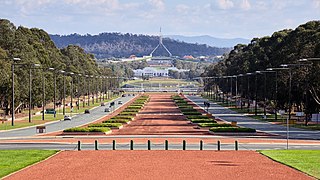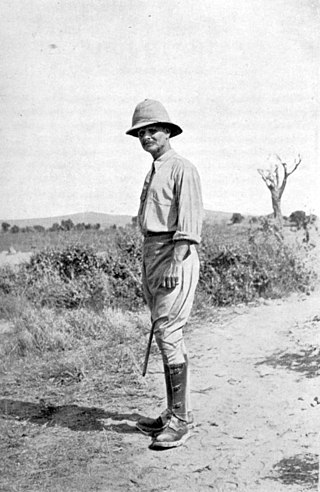
Sir Robert Gordon Menzies was an Australian politician and lawyer who served as the 12th prime minister of Australia from 1939 to 1941 and from 1949 to 1966. He held office as the leader of the United Australia Party (UAP) in his first term, and subsequently as the inaugural leader of the Liberal Party of Australia, which he was responsible for establishing and defining in policy and political outreach. He is the longest-serving prime minister in Australian history.

Sir Arthur William Fadden was an Australian politician and accountant who served as the 13th prime minister of Australia from 29 August to 7 October 1941. He was the leader of the Country Party from 1940 to 1958 and served as treasurer of Australia from 1940 to 1941 and 1949 to 1958.

Felix Weihs de Weldon was an Austrian sculptor. His most famous pieces include the United States Marine Corps War Memorial in the Arlington National Cemetery, Virginia, US, and the Malaysian National Monument (1966) in Kuala Lumpur.

The Australian War Memorial (AWM) is a national war memorial and museum dedicated to all Australians who died as a result of war. The AWM is located in Campbell, a suburb of the Australian capital of Canberra. The grounds include five buildings and a sculpture garden. Most of the museum galleries and commemorative areas are contained in the Memorial Building.

Lake Burley Griffin is an artificial lake in the centre of Canberra, the capital of Australia. It was completed in 1963 after the Molonglo River, which ran between the city centre and Parliamentary Triangle, was dammed. It is named after Walter Burley Griffin, the architect who won the competition to design the city of Canberra.

The India Gate is a war memorial located near the Rajpath on the eastern edge of the "ceremonial axis" of New Delhi. It stands as a memorial to 74,187 soldiers of the Indian Army who died between 1914 and 1921 in the First World War, in France, Flanders, Mesopotamia, Persia, East Africa, Gallipoli and elsewhere in the Near and the Far East, and the Third Anglo-Afghan War. 13,300 servicemen's names, including some soldiers and officers from the United Kingdom, are inscribed on the gate. Designed by Sir Edwin Lutyens, the gate evokes the architectural style of the ancient Roman triumphal arches such as the Arch of Constantine in Rome, and later memorial arches; it is often compared to the Arc de Triomphe in Paris, and the Gateway of India in Mumbai.

George Rayner Hoff was a British-born sculptor who mainly worked in Australia. He fought in World War I and is chiefly known for his war memorial work, particularly the sculptures on the Anzac War Memorial in Sydney.

The Anzac Memorial is a heritage-listed war memorial, museum and monument located in Hyde Park South near Liverpool Street in the CBD of Sydney, Australia. The Art Deco monument was designed by C. Bruce Dellit, with the exterior adorned with monumental figural reliefs and sculptures by Rayner Hoff, and built from 1932 to 1934 by Kell & Rigby. This state-owned property was added to the New South Wales State Heritage Register on 23 April 2010.

Old Parliament House, formerly known as the Provisional Parliament House, was the seat of the Parliament of Australia from 1927 to 1988. The building began operation on 9 May 1927 after Parliament's relocation from Melbourne to the new capital, Canberra. In 1988, the Commonwealth Parliament transferred to the new Parliament House on Capital Hill. Since 2009, Old Parliament House has become a museum about the building and Australian democracy more broadly, named the Museum of Australian Democracy at Old Parliament House (MoAD). It also serves as a venue for temporary exhibitions, lectures and concerts.

Anzac Parade is a significant road and thoroughfare in the Australian capital Canberra, used for ceremonial occasions and the site of many major military memorials.
The Australian–American Memorial is in Canberra, the national capital of Australia, and commemorates the help given by the United States during the Pacific War.

Field marshal is the highest rank of the Australian Army, and is currently held by Charles III, King of Australia. The rank was created as a direct equivalent of the British military rank of field marshal. It is a five-star rank, equivalent to the ranks in the other armed services of Admiral of the Fleet in the Royal Australian Navy, and Marshal of the Royal Australian Air Force. The subordinate army rank is general.

Henry Baynton Somer "Jo" Gullett, AM, MC was an Australian soldier, politician, grazier, diplomat and journalist. He served with distinction in the Australian Army during World War II, was a controversial Liberal member of the Australian House of Representatives for the Division of Henty, from 1946 to 1955. Gullett served as the Australian Ambassador to Greece from 1965 to 1968, during 'the time of the Colonels'.

Sir Edgar Bertram Mackennal, usually known as Bertram Mackennal, was an Australian sculptor and medallist, most famous for designing the coinage and stamps bearing the likeness of George V. He signed his work "BM".
The Prime Ministers Avenue is a collection of busts of the first twenty-nine prime ministers of Australia. They are lined along an avenue of horse chestnuts at the Ballarat Botanical Gardens, bronze casts mounted on polished granite pedestals.

The National War Memorial (South Australia) is a monument on the north edge of the city centre of Adelaide, South Australia that commemorates South Australians who served in the First World War and those who gave their lives. It was opened in 1931. The memorial is on the corner of North Terrace and Kintore Avenue, next to the grounds of Government House. Observances are held at the site throughout the year, with major services on Anzac Day (25 April) and Remembrance Day (11 November).

The South African War Memorial is an equestrian memorial dedicated to the South Australians who served in the Second Boer War of 11 October 1899 to 31 May 1902. It was the first war in which South Australians fought, and 1,531 men were sent in nine contingents, with over 1,500 horses to accompany them. Over 59 South Australians died in the war.
Russell George Foskett, was an Australian aviator and flying ace of the Second World War. Born in a suburb of Sydney, Foskett was employed as a clerk in 1940 when he enlisted in the Royal Australian Air Force. Accepted as a pilot under the Empire Air Training Scheme, he completed his training in Australia and Southern Rhodesia, before transferring for service over North Africa. In subsequent aerial engagements, Foskett was officially credited with the destruction of 61⁄2 Axis aircraft and awarded the Distinguished Flying Cross. Appointed to command No. 94 Squadron RAF, he was transferred to the Mediterranean Theatre in 1944. Foskett was killed on 31 October 1944, after his aircraft developed engine trouble and he was forced to bail out over the Aegean Sea, where his parachute failed to open.

The history of Lake Burley Griffin, an artificial body of water in Canberra, the capital of Australia, is highly complex. Following its initial design in the 1910s, extensive political disputes occurred until it was finally built in the 1960s.

Richard Gavin Gardiner Casey, Baron Casey was an Australian statesman who served as the 16th governor-general of Australia, in office from 1965 to 1969. He was also a distinguished army officer, long-serving cabinet minister, Ambassador to the United States, member of Churchill's War Cabinet, and Governor of Bengal.

















